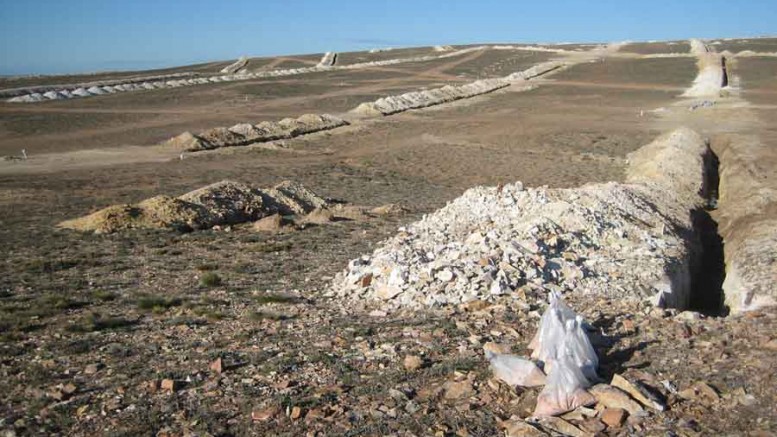Lima-based Minera IRL (IRL-T) is moving ahead with building its second small gold mine, after having tabled a positive feasibility study in February for its Don Nicolas epithermal gold-silver project in Argentina’s Patagonia region.
Located 100 km inland from the South Atlantic in mining-friendly Santa Cruz province, Minera IRL’s Don Nicolas property package comprises 2,700 sq. km of the prospective Deseado Massif volcanic complex. Minera IRL picked up the property through its acquisition of U.K.-based Hidefield Gold in 2009, and then carried out a major exploration program that included 24,000 metres of infill and extension drilling (see TNM Oct. 31–Nov. 6/11 for a site visit report).
A quick look through the new feasibility study and its small resource shows it’s been written not to gussy up an asset for a quick sale, but as a blueprint for a miner who wants to quickly and cheaply put a mine into production that can serve as a hub for undeveloped gold prospects that could feed a central mill in the years to come.
Prepared by consulting firm Tetra Tech, the feasibility study zeroes in on exploiting two low-sulphidation, epithermal gold vein fields located a truckable 50 km apart: La Paloma and Martinetas.
Resources and reserves have been divided into a higher-grade category earmarked for conventional milling, and lower grade material that would be stockpiled and perhaps heap-leached later if metallurgical studies prove fruitful.
The “high-grade” (above 1.6 grams gold per tonne) measured and indicated resource stands at 1.5 million tonnes grading 6 grams gold and 13 grams silver, for 278,000 contained oz. gold and 639,000 contained oz. silver. Within that tonnage is a proven and probable reserve of 1.2 million tonnes grading 5.1 grams gold and 10 grams silver for 197,000 oz. gold and 401,100 oz. silver.
Consulting firm Coffey Mining calculated the resource estimate last year.
Ore from various shallow open pits would be treated at a central, conventional carbon-in-leach mill at a rate of 350,000 tonnes per year to produce an average of 52,400 oz. gold and 56,000 oz. silver per year over an initial mine life of 3.6 years. Recovery rates would be 92.1% for gold and 47.4% for silver.
Pre-production capital costs would be US$55.5 million and sustaining capital costs would be US$7 million, generating a life-of-mine total cash cost of US$528 per oz. gold after silver credits and excluding royalties. On a per-tonne basis, the life-of-mine cash operating cost would be US$82.5 per tonne of ore.
At a gold price of US$1,500 per oz., the project has an after-tax net present value of US$48 million at a 5% discount rate, and an internal rate of return of 38% after tax. Payback would be in a year and half.
The logistics are excellent, with flat, desolate land, ample water discovered on the property, a major highway running between the two key vein fields and potential to hook up the site to the national electrical grid.
Minera IRL isn’t sitting still with the resource: in March at Martinetas it launched a 12,000-metre reverse-circulation drilling program that the company says is “expected to add significantly to the mine life.”
Minera IRL considers the La Paloma vein field to be prospective for future underground mining of large, high-grade veins such as Sulfuro, which could only be accessed using a shallow pit under the current, limited mine plan.
The additional “low-grade” indicated resource at Don Nicolas totals 4.2 million tonnes at 0.8 gram gold and 4 grams silver for a contained 102,000 oz. gold and 516,000 oz. silver. Minera IRL expects to stockpile 2.1 million tonnes of this material as it mines the proven and probable reserves outlined above.
Other targets on the Don Nicolas property include Escondido in the north; Michelle to the southwest, near AngloGold Ashanti’s Cerro Vanguardia mine; and Chispas to the southeast.
Minera IRL has budgeted US$8 million for exploration in Patagonia in 2012, of which 60% will be spent on discovery drilling and 13% will be spent on geophysical and geochemical vectoring techniques.
Minera IRL has consultants Ausenco Vector working on an environmental impact assessment at Don Nicolas, and the miner expects to have the permitting process largely completed in the second half of this year. With mine development to take 12 months, Minera IRL is pencilling in the fourth quarter of 2013 as the target for first gold production.
Minera IRL already operates its small, four-year-old Corihuarmi gold mine as a heap-leach operation at a high altitude in Peru, where it also has its promising underground Ollachea gold-development project.
For 2011, the company had a total income after tax of US$9.6 million on record sales revenue of US$53 million, compared with a profit of US$2.8 million on sales of US$41.1 million in 2010. Gold sales in 2011 were 33,718 oz. gold, up from 33,240 oz. gold in 2010. Cash costs rose 7% in 2011 to US$410 per oz. gold due to an increase in ore mined.
In March 2012, Minera IRL topped up its depleted treasury by closing a $33.1-million offering led by bookrunner RBC Capital Markets, and issuing 29.3 million shares at $1.13 per share.
The company had 151.1 million shares outstanding in mid-April, and they traded for $1.06 at presstime.


Be the first to comment on "All systems go for Minera IRL in Patagonia"